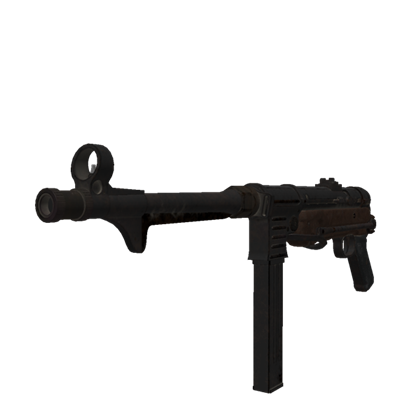
This image has format transparent PNG with resolution 420x420.
You can download this image in best resolution from this page and use it for design and web design.
MP 40 PNG with transparent background you can download for free, just click on download button.
The MP 40 (Maschinenpistole 40) is a submachine gun chambered for the 9?19mm Parabellum cartridge. It was developed in Nazi Germany and used extensively by the Axis powers during the Second World War.
Designed in 1938 by Heinrich Vollmer with inspiration from its predecessor the MP 38, it was heavily used by infantrymen (particularly platoon and squad leaders), and by paratroopers, on the Eastern and Western Fronts. Its advanced and modern features made it a favorite among soldiers and popular in countries from various parts of the world after the war. It was often erroneously called "Schmeisser" by the Allies, although Hugo Schmeisser was not involved in the design or production of the weapon. From 1940 to 1945, an estimated 1.1 million were produced by Erma Werke.
The Maschinenpistole 40 ("Machine pistol 40") descended from its predecessor the MP 38, which was in turn based on the MP 36, a prototype made of machined steel. The MP 36 was developed independently by Erma Werke's Berthold Geipel with funding from the German Army. It took design elements from Heinrich Vollmer's VPM 1930 and EMP. Vollmer then worked on Berthold Geipel's MP 36 and in 1938 submitted a prototype to answer a request from the Heereswaffenamt (Army Weapons Office) for a new submachine gun, which was adopted as MP 38. The MP 38 was a simplification of the MP 36, and the MP 40 was a further simplification of the MP 38, with certain cost-saving alterations, most notably in the more extensive use of stamped steel rather than machined parts.
The MP 40 was often called the "Schmeisser" by the Allies, after the weapon designer Hugo Schmeisser. Schmeisser had designed the MP 18, which was the first mass-produced submachine gun in the world, and carried some resemblance to the MP 40. He did not, however, have anything to do with the design or development of the MP 40, although he held a patent on the magazine
The MP 40 submachine guns are open-bolt, blowback-operated automatic arms. The only mode of fire was fully automatic, but the relatively low rate of fire enabled single shots with controlled trigger pulls. The bolt features a telescoping return spring guide which serves as a pneumatic recoil buffer. The cocking handle was permanently attached to the bolt on early MP 38s, but on late production MP 38s and MP 40s, the bolt handle was made as a separate part. It also served as a safety by pushing the head of handle into one of two separate notches above the main opening; this action locked the bolt either in the cocked (rear) or uncocked (forward) position. The absence of this feature on early MP 38s resulted in field expedients such as leather harnesses with a small loop, used to hold the bolt in forward position.
The MP 38 receiver was made of machined steel, but this was a time-consuming and expensive process. To save time and materials, and thus increase production, construction of the MP 40 receiver was simplified by using stamped steel and electro-spot welding as much as possible. The MP 38 also features longitudinal grooving on the receiver and bolt, as well as a circular opening on the magazine housing. These features were eliminated on the MP 40.
One unique feature found on most MP 38 and MP 40 submachine guns was an aluminum, steel, or bakelite resting bar or support under the barrel. This was used to steady the weapon when firing over the side of open-top armored personnel carriers such as the Sd.Kfz. 251 half-track. A handguard, made of a synthetic material derived from bakelite, was located between the magazine housing and the pistol grip. The barrel lacked any form of insulation, which often resulted in burns on the supporting hand if it was incorrectly positioned. The MP 40 also had a forward-folding metal stock, the first for a submachine gun, resulting in a shorter overall weapon when folded. However, this stock design was at times insufficiently durable for hard combat use.
Although the MP 40 was generally reliable, a major weakness was its 32-round magazine. Unlike the double-column, dual-feed magazine insert found on the Thompson M1921-28 variants, the MP 40 used a double-column, single-feed insert. The single-feed insert resulted in increased friction against the remaining cartridges moving upwards towards the feed lips, occasionally resulting in feed failures; this problem was exacerbated by the presence of dirt or other debris. Another problem was that the magazine was also sometimes misused as a handhold. This could cause the weapon to malfunction when hand pressure on the magazine body caused the magazine lips to move out of the line of feed, since the magazine well did not keep the magazine firmly locked. German soldiers were trained to grasp either the handhold on the underside of the weapon or the magazine housing with the supporting hand to avoid feed malfunctions.
In this page you can download free PNG images: MP 40 PNG images free download